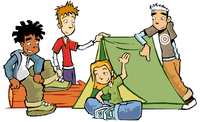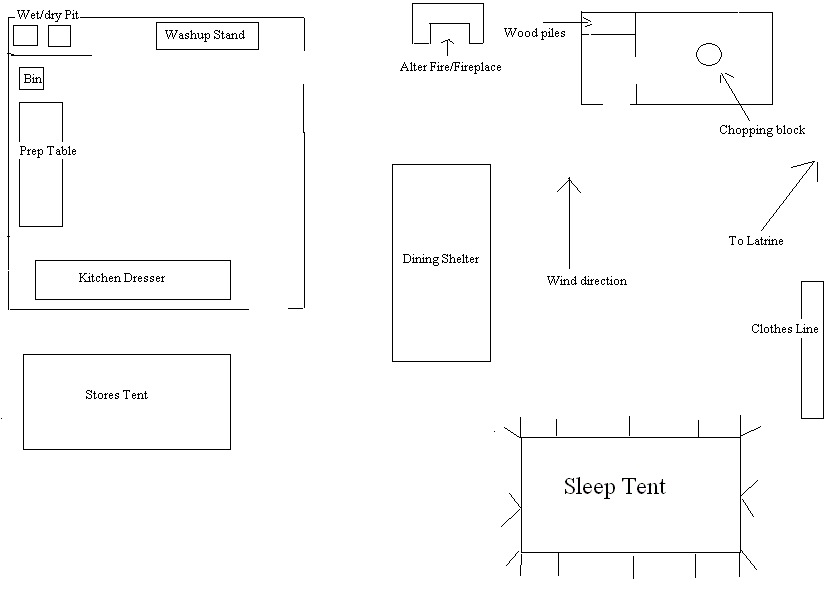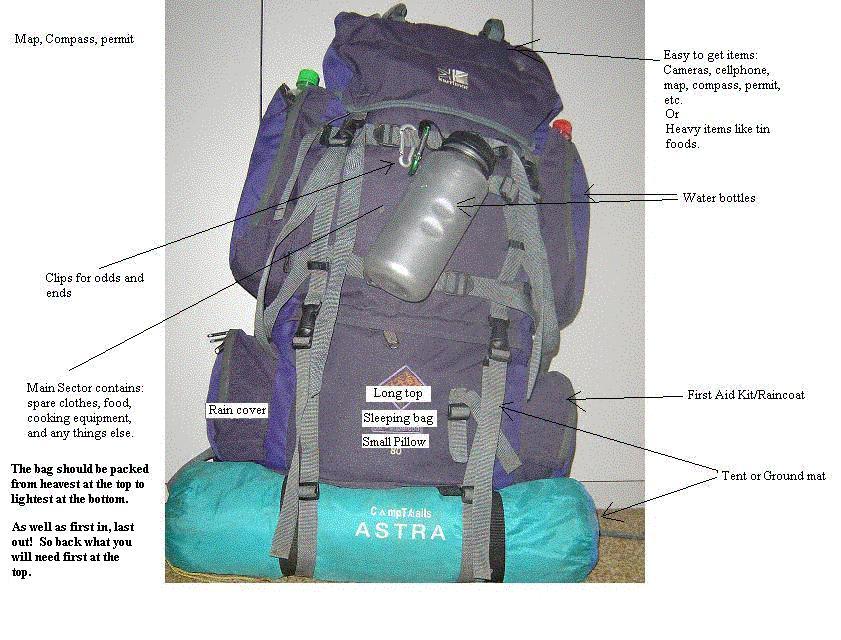
CAMPING

 |
CAMPING |
 |


1. Make a layout plan of a typical Patrol campsite. Show the position of the camp kitchen, the fireplace, dining flysheet, latrine, and tentage for at least six Scouts. Explain how and why weather, season, wind, fuel, and water supply are taken into consideration when choosing a site. Explain what care to take with regard to safe water, sanitary facilities, and emergencies.

Wind Direction: It is important to lay your campsite out with regard to the correct wind direction. Your aim is for the wind to keep the smoke blowing out of camp and the smell of the latrine to keep far away. The diagram above shows how a campsite should be laid out to achieve this. When you come to think about it, its all common sense.
Wood and Water: Your location of the site should be close to both water and a large wood supply. It is important to have enough to prevent sanitary problems. Camping at a place without a good and safe water supply can be dangers and is never a good idea. Before drinking water from a river, check to see that it is safe (e.g. Are their fish swimming around or phone the local water board). With any river water, safe or unsafe boil and filter it before drinking it.
With regards to wood, if it is you only source of fuel, it can be just as dangers. Uncooked food is bound to make you sick and meats like pork can put you in the hospital. Now days with Gas equipment cheaply available, it a good idea to take some just incase. Some may say this is not how scouts should do it, but for those, remember out scout motto: Be Prepared and that means for anything.
2. Explain how a Patrol's typical activities are organised in setting up camp (eg pitching tents, digging latrines, making the kitchen etc). List the duties you would allocate to each member of the Patrol during camp.
A good patrol leader plans in advance to avoid arguments on camp. For any patrol, there should be a setup list; cooking and dishwashing list, a take down list and a list for any other jobs that are required.
Setup list: This should include a list of all the jobs required to setup camp and the name of the patrol member who will be doing them. For this to work well, the jobs need to be fair and cater for the ability of the members. Don't make the youngest member dig the toilets, the wet/dry pits and fetch the mud for the alter fire! What could he/she possible learn from that? Remember that as a patrol leader: You should not ask someone to do a job; you are not prepared to do yourself! Its a good idea to switch the guys do the boring jobs around half way through (like the toilets) or when doing your rounds, why not give a hand to show some encouragement.
Cooking cleaning list: With this list, the same goes; don't make the youngest members wash all the dishes, while you never left a finger. Also, remember that those that cook should not have to clean the same meal.
Take down list: Like the setup list, but in reverse. Pack away things as you finish with them, this will safe you a lot of time at the end!
3. Prepare a checklist detailing:
a) the personal kit that you will need for a Troop camp lasting a week;
b) the personal kit that you will need for a weekend hike or cruise
i. in summer
ii. in winter;
Here is the kit list we give for an over night forest hike:
Clothesc) all the camping equipment needed for a weekend Patrol standing camp. Be able to justify your choice.
There are certain things that will be required for any camp, such as tents, but most equipment will depend on the program, menu and location of the camp. For example: If you are eating only hotdogs, there is no reason to bring a Dutch oven along, a small pot will do or if you having a backwoodsman camp a knife is all you require. The same applies with the program, if going to play handball, you require a ball of some sort. If you plan to teach axemanship or chop wood, you require an axe, but if you going on a hike with gas stoves, there is no need for an axe. With regards to location, having certain features will require or subtract from equipment. Example: A river will allow for swimming, while a big open field allows fro pioneering and games.4. Demonstrate how to pack correctly your personal kit in a rucksack or kitbag for an overnight Patrol camp.
